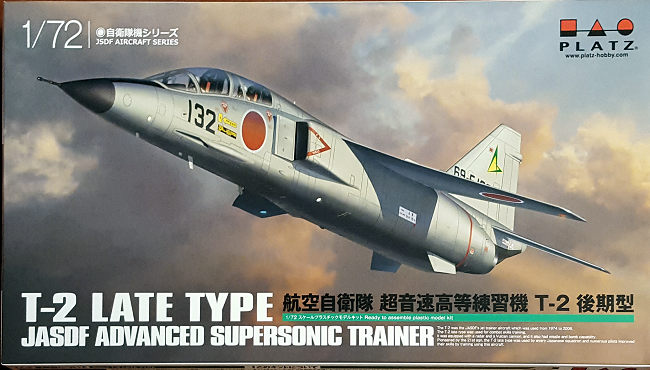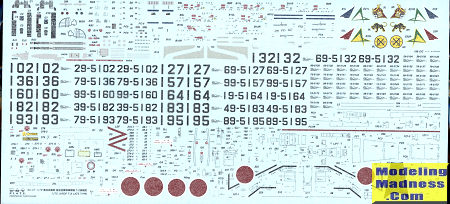
Platz 1/72 T-2 Late Type
| KIT #: | AC-21 |
| PRICE: | 2800 yen |
| DECALS: | At least eleven options |
| REVIEWER: | Scott Van Aken |
| NOTES: | 2017 release |

| HISTORY |
The T-2's configuration was clearly reminiscent of that of the two-seat Jaguar, with the two aircraft having the same overall configuration and some resemblance in details. In particular, the T-2 was also powered by two Rolls-Royce Turbomeca Adour turbofans, the same engines used by the Jaguar, license-built by Ishikawajima-Harima Heavy Industries under the designation "TF40-IHI-801A".
Despite this similarity, the T-2 was not a copy of the Jaguar, and the two aircraft could be distinguished at a glance, the T-2 having a more dartlike appearance, being noticeably longer and having a distinctly shorter wingspan than the Jaguar. The T-2 also had many detail differences. For example, since the JASDF had no rough-field requirement, the T-2 had conventional single-wheeled landing gear and not the distinctive heavy duty landing gear of the Jaguar.
The T-2 was made mostly of aircraft aluminum alloys, though it featured selective use of titanium. The high-mounted wings had a leading edge sweep of 42.5° and a 9° anhedral. The wings feature noticeable "leading edge root extensions (LERX)" and full-span leading edge slats, with a "dogtooth" discontinuity on the outer edge of the span, though the dogtooth did not split the slat. There was a single ¾-span flap on the trailing edge, unlike the full-span double-slotted split flaps of the Jaguar, but the T-2 did have twin spoilers on each wing just forward of the flap for roll control instead of ailerons, another element clearly derived from the Jaguar. There was a small fence mounted inboard on the top of the wing. There were no fuel tanks in the wings.
The tail assembly was conventional, featuring slab all-moving tailplanes with an anhedral of 15°. The steep anhedral kept the tailplanes out of the engine exhaust while allowing them to remain effective through the wing wash. Like the Jaguar, there was a fixed ventral fin under each exhaust, while two hydraulically operated airbrakes are fitted just forward of each ventral fin.
Each Adour engine provided 22.75 kN (5,115 lbf) max dry thrust and 32.49 kN (7,305 lbf) afterburning thrust. The TF40-801As did not have the "part throttle reheat" feature added to Adour 102s as an engine-out safety feature, and the T-2 was never refitted with more powerful Adour engine variants, along the lines of the Adour 104 eventually refitted to British Jaguars, leaving the T-2 somewhat underpowered. The engine intakes had fixed rectangular geometry and fuselage splitter plates, plus a set of spring-loaded auxiliary inlets behind the intake lip for increased airflow in ground running. There were large service doors beneath the fuselage that provided excellent access to the engines for maintenance.
The T-2's tricycle landing gear all featured single wheels, with the nose gear retracting backward and the main gear retracting forward into the fuselage, rotating 90° to lie flat, and incorporated an antiskid control system. The nose gear was offset slightly to the right, with a small fixed vertical airfoil mounted in front of it to compensate for the extended nose gear's tendency to cause yaw. A runway arresting hook was fitted under the tail behind the engine exhausts.
A total of 90 production T-2s were built, including 28 unarmed "T-2(Z)s", or "Zenkigata (early type)" and 62 armed "T-2(K)s", or "Kokigata (late type)"; some sources translate these variants as "T-2A" and "T-2B" respectively. An additional two T-2(Z)s were built but modified for the S-FX / F-1 strike fighter program. The last T-2 rolled off the assembly line in 1988.
The T-2 service in 1975, with the first unit, the 21st Hikōtai becoming fully operational on 1 October 1976, with a second squadron, the 22nd Hikōtai following on 5 April 1978, allowing the North American F-86 Sabre to be phased out of the advanced training role. The "Blue Impulse" aerobatic display team of the JASDF re-equipped with the T-2 in the winter of 1981–82. T-2s were also used by a dedicated Aggressor squadron, being replaced by the McDonnell Douglas F-15 Eagle. T-2s were also used as conversion trainers for squadrons operating the Mitsubishi F-1, a development of the T-2.
The T-2 was retired by 2006, being replaced as an advanced trainer by the Kawasaki T-4 and as a conversion trainer by a two-seat version of the Mitsubishi F-2, which had replaced the F-1 in the anti-ship strike/ground attack role.
| THE KIT |
 This
is the third boxing that I have previewed, the other two being a Blue Impulse
boxing and the other the special CCV. There was also one of the early version
that I've not seen, but I'm betting it is mostly a decal difference. The
kit has superbly engraved panel lines with indented
fastener detail. I know some do not like it, but it looks great on this one.
There are quite a few sprues, several of them dedicated to weapons and things
under wings. The kit has previously been boxed as an F-1 since most of the parts
are the same on both planes. There are unused parts on the sprues for the
single seat version.
This
is the third boxing that I have previewed, the other two being a Blue Impulse
boxing and the other the special CCV. There was also one of the early version
that I've not seen, but I'm betting it is mostly a decal difference. The
kit has superbly engraved panel lines with indented
fastener detail. I know some do not like it, but it looks great on this one.
There are quite a few sprues, several of them dedicated to weapons and things
under wings. The kit has previously been boxed as an F-1 since most of the parts
are the same on both planes. There are unused parts on the sprues for the
single seat version.
The cockpit is very nicely done with a dual seat tub. Instrument panels and side consoles have raised detailing and you have decals that you can place over them if you wish. The seat is a single piece and while nicely done, could stand a resin replacement. No harness detail, of course. Both canopies are separate and come with actuating gear.
Intakes are nice and deep and while there is no blanking plate, one is not really needed. As is the case with every aircraft designed like this, there is a lower section to the fuselage that has to be fit in place. Down there are also dual speed brakes and there are a pair of stabilizing fins that will need the holes opened before installation. The leading edge slats on the one piece upper wing are separate and should be slightly drooped on the ground. The lower wing inserts will need to have pylon mounting holes opened.
Landing gear are relatively complex and Platz has pulled it off well. Though separate, the forward main gear doors are normally closed as is the main nose gear door. There are pylons for the seven weapons locations. Among the things that can be carried under wings are Sidewinders, fuel tanks, ASM-1 missiles, and CBLS-200 bomb rack. The Sidewinders and ASM-1s are really not needed for this boxing as the trainers did not carry weapons. It is up to the builder to decide if they want to use any of the pylons as it was not uncommon for these planes to fly 'clean'.
 Instructions
are very nicely done and provide Gunze as well as Model Master paint references.
All the markings options are painted in flat light gull grey, so painting will
be pretty easy for the most part. Unlike the 'early' variant, all the unit
markings are small, but this allows eleven different options. Most are for the
21st and 22nd Squadrons of the 4th Wing, which was the training wing. Two others
are for hacks assigned to F-1 units, specifically 3 and 6 Squadron. While not
shown in the instructions, a tail marking for 8 Squadron is also provided. A
full stencil suite is also provided. Decals are very nicely done and should take
a bit to attach all the stencils.
Instructions
are very nicely done and provide Gunze as well as Model Master paint references.
All the markings options are painted in flat light gull grey, so painting will
be pretty easy for the most part. Unlike the 'early' variant, all the unit
markings are small, but this allows eleven different options. Most are for the
21st and 22nd Squadrons of the 4th Wing, which was the training wing. Two others
are for hacks assigned to F-1 units, specifically 3 and 6 Squadron. While not
shown in the instructions, a tail marking for 8 Squadron is also provided. A
full stencil suite is also provided. Decals are very nicely done and should take
a bit to attach all the stencils.
| CONCLUSIONS |
This really looks like a great kit. I should get off my keester and actually build one of these as I think I'm probably missing out on a positive experience. If you have one of the old Hasegawa T-2 kits, you may well want to consider upgrading to the Platz kit.
| REFERENCES |
http://en.wikipedia.org/wiki/Mitsubishi_T-2
August 2017
My thanks to Platz
Model for the preview kit. If
your local retailer doesn't carry it, ask them to order it for you.
Copyright ModelingMadness.com. All rights reserved.
If you would like your product reviewed fairly and fairly quickly, please contact the editor or see other details in the Note to Contributors.
Back to the Main Page Back to the Review Index Page Back to the Previews Index Page